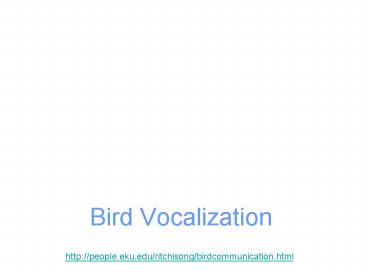Bird Vocalization - PowerPoint PPT Presentation
1 / 15
Title:
Bird Vocalization
Description:
Understanding bird language is an important naturalist skill and research tool. In the northern hemisphere, the are also a harbinger of spring's approach. All Year ... – PowerPoint PPT presentation
Number of Views:736
Avg rating:3.0/5.0
Title: Bird Vocalization
1
Bird Vocalization
http//people.eku.edu/ritchisong/birdcommunication
.html
2
Purpose of Vocalizations
- Contact or association calls
- Alarm calls
- Juvenile begging
- Territorial calls and songs associated with
reproduction - Lays out territorial boundaries
- Signals to potential rivals that territory is
occupied - Advertises prowess as potential mate
- Indicates location within territory
3
Components of Vocalizations
- Rhythm
- Pitch
- Volume
- Tonal quality
- Syntax sequence ofa series of particular notes
Combined, these acoustic details allow for
species recognition AND, in many species, for
conspecifics to recognize individuals e.g.,
young, parents, mates, neighbors.
4
Song vs. Calls
- Differentiated by length and complexity of
vocalization - Calls are simple, have discrete purpose, and
innately known - Songs are well-developed, multi-purposed, and are
partly or entirely learned - Songs are particularly well-developed in
passerines - Other orders sing with other body parts
- Bird brains
5
Mechanics of Vocalizations
- Vocalizations produced by the syrinx (syringes)
voice or song organ in birds. - The syrinx is a bony structure surrounded by an
air sac and modified by syringeal muscles. - Syrinx is analogous to larynx in mammals, but is
located at the bottom rather than the top of the
trachea (windpipe) allows it to become a
resonating chamber. - Two sides of syrinx independently controlled
allows for highly complex songs and two voice
phenomenon.
http//people.eku.edu/ritchisong/birdcommunication
.html
6
Song Repertoire Size
7
Mimics
- Parrots
- Family Mimidae (Mimics)
- Mockingbird
- Gray Catbird
- Brown Thrasher
- Family Corvidae (Corvids)
- Jays
http//people.eku.edu/ritchisong/birdcommunication
.html
8
Bird Language
- Paul Rezendez, Tracking and the Art of Seeing
How to Read Animal Tracks and Sign - Tom Brown, Tom Brown's Field Guide to Nature
Observation and Tracking - www.trackerschool.com
- John Young, Advanced Bird Language
- http//www.natureskills.com/language_of_the_birds.
html
9
Overall.
- Birds can have rich and varied repertoires of
calls and songs - Some of most varied vocalizations in all of
animal kingdom, comparable to non-human primates - These vocalizations have varied purposes
- For humans, they are a source of beauty and
inspiration - Understanding bird language is an important
naturalist skill and research tool - In the northern hemisphere, the are also a
harbinger of springs approach
10
All Year
- Red-tailed Hawk (Bald Eagle)
- Ring-necked Pheasant
- Mourning Dove
- American Crow
- Blue Jay
11
All But Winter
- Canada Goose
- Mallard
- Belted Kingfisher
12
Winter
- Dark-eyed Junco
- Great-Horned Owl
13
Late Winter-Early Spring
- American Kestrel
- Barred Owl
- Red-bellied Woodpecker
- Downy Woodpecker
- Black-capped Chickadee
- White-breasted Nuthatch
- Northern Cardinal
- House Finch
14
Early Spring
- Northern Flicker
- American Robin
- Red-winged blackbird
- Common Grackle
- Chipping Sparrow
- Song Sparrow
15
Late Spring-Summer
- Red-eyed Vireo
- House Wren
- Eastern Bluebird
- Gray Catbird
- Field Sparrow
- Rose-breasted Grosbeak
- Indigo Bunting
- Dickcissel
- Eastern Meadowlark
- Brown-headed Cowbird
- American Goldfinch































